Introduction
In corporate transactions such as mergers, acquisitions, and strategic investments, one crucial aspect often defines the quality of the deal—due diligence in corporate law. While financials, operations, and tax compliance get plenty of attention, legal due diligence—especially litigation analysis—is often underestimated.
Litigation analysis is not just a background check; it's a powerful diagnostic tool that uncovers potential legal threats, historical risk patterns, and unresolved liabilities. For legal and investment professionals, this data provides deep insight into how past and ongoing disputes may impact future operations.
In this article, we explore why litigation analysis is a vital component of legal due diligence and how it can shape strategic decisions in corporate deals.
What Is Litigation Analysis in Due Diligence
Litigation analysis involves identifying, reviewing, and assessing all past and pending legal disputes involving the target company. This includes:
- Civil, criminal, and commercial cases
- Consumer complaints
- Regulatory investigations
- Arbitration proceedings
- Tax or labor disputes
By analyzing these cases, legal teams can understand the risk profile of a company and evaluate potential legal and financial exposure before the deal is finalized.
Why Litigation Analysis Matters in M&A
When a company is acquired, its litigation history doesn’t disappear. It becomes the acquirer’s responsibility. Here's why litigation analysis is central to corporate law due diligence:
- Identifies undisclosed liabilities that could affect valuation
- Protects the buyer from inheriting legal complications
- Reveals operational or compliance gaps that may need immediate correction
- Strengthens negotiation by highlighting risks that justify price adjustment or indemnity clauses
In short, litigation analysis provides foresight—and foresight is protection in deal-making.
Key Areas of Litigation to Investigate
Here are the primary types of litigation that legal due diligence should focus on:
1. Commercial Disputes
Review disputes with vendors, clients, or partners over contracts, delivery failures, or service breaches.
Unresolved commercial litigation can lead to liabilities or damaged business relationships.
2. Regulatory and Statutory Cases
Cases initiated by regulatory bodies such as SEBI, RBI, GST authorities, or labor departments can indicate serious compliance failures.
3. Labor and Employment Disputes
Pending wage disputes, wrongful termination cases, or harassment claims point to cultural or legal issues in workforce management.
4. Consumer Complaints
Frequent consumer litigation or complaints may reflect poor quality control, deceptive practices, or lack of grievance mechanisms.
5. Tax and Financial Litigation
Open tax-related disputes with authorities could turn into penalties, interest burdens, or frozen assets post-acquisition.
What Litigation Analysis Reveals That Contracts Don’t
While document review confirms legal rights and obligations, litigation analysis tells you how the company behaves under legal pressure. It uncovers:
- How often the company is sued
- The average time it takes to resolve disputes
- The nature and geography of legal risks
- The involvement of key executives in legal proceedings
This behavioral insight often highlights cultural red flags and habitual negligence that contracts alone may not reflect.
Litigation Trends as a Risk Signal
In modern legal due diligence, pattern recognition is essential. If a company is involved in similar types of disputes repeatedly—say, delayed vendor payments or workplace violations—it may suggest systemic problems.
Analyzing trends in litigation helps identify:
- Recurring risk areas
- Weak compliance systems
- Sectors or geographies prone to disputes
- Legal vulnerabilities that need to be mitigated post-acquisition
These trends also aid in building effective representations, warranties, and indemnities in the transaction agreement.
Speeding Up Litigation Analysis with Technology
Manually tracking court cases, accessing judgment archives, or validating party names can take weeks. Advanced legal intelligence tools like LegitQuest now offer technology-driven litigation analysis that is faster, more reliable, and data-rich.
How LegitQuest Supports Litigation Due Diligence:
- Automated search of case history across Indian courts
- Name-match intelligence to track directors and related entities
- Custom reports summarizing litigation volumes and risk levels
- Filters to segment cases by type, status, court, or parties involved
This not only reduces manual effort but also ensures no critical case is missed during the due diligence phase.
Integrating Litigation Analysis with Broader Legal Due Diligence
Litigation data shouldn’t be seen in isolation. Instead, it should be cross-mapped with other legal areas:
- Contractual obligations: Are there cases arising from contract breaches
- Compliance checks: Do litigation patterns point to weak internal controls
- Intellectual property: Are there disputes around trademarks or patents
- Real estate: Are properties under legal contention
This integrated approach enables a holistic risk evaluation and strengthens the overall due diligence process.
The Role of Legal Teams in Interpretation
Raw case data isn’t enough. It must be analyzed for materiality, outcome probability, and strategic impact. Legal advisors should evaluate:
- The financial exposure of each ongoing case
- The likelihood of adverse rulings
- The enforceability of judgments
- Any risk of reputational harm
Litigation doesn’t automatically block a deal—but knowing the weight of legal exposure allows buyers to negotiate better, demand indemnity protections, or stagger payments.
Case Study: Using LegitQuest in a Real-World M&A Deal
In a recent mid-cap acquisition in India, the acquiring legal team used LegitQuest’s litigation search tool to identify undisclosed labor court cases filed against the target’s warehouse operations across three states.
The cases had not been mentioned in the seller’s disclosure. The discovery led to:
- A revised valuation
- A separate escrow for labor-related liabilities
- Mandatory corrective actions pre-closing
Without technology-driven litigation analysis, these risks would have gone unnoticed.
In today's high-stakes deal environment, ignoring litigation history is a costly mistake. Litigation analysis is not optional—it’s essential. It reveals legal liabilities, behavioral patterns, and compliance maturity.
By integrating litigation analysis into due diligence in corporate law, acquirers and investors ensure they are not just buying growth—they are avoiding risk.
LegitQuest empowers legal teams with AI-powered litigation intelligence, enabling faster, smarter, and deeper risk discovery. In an era where data drives decisions, smart litigation analysis is your edge.
